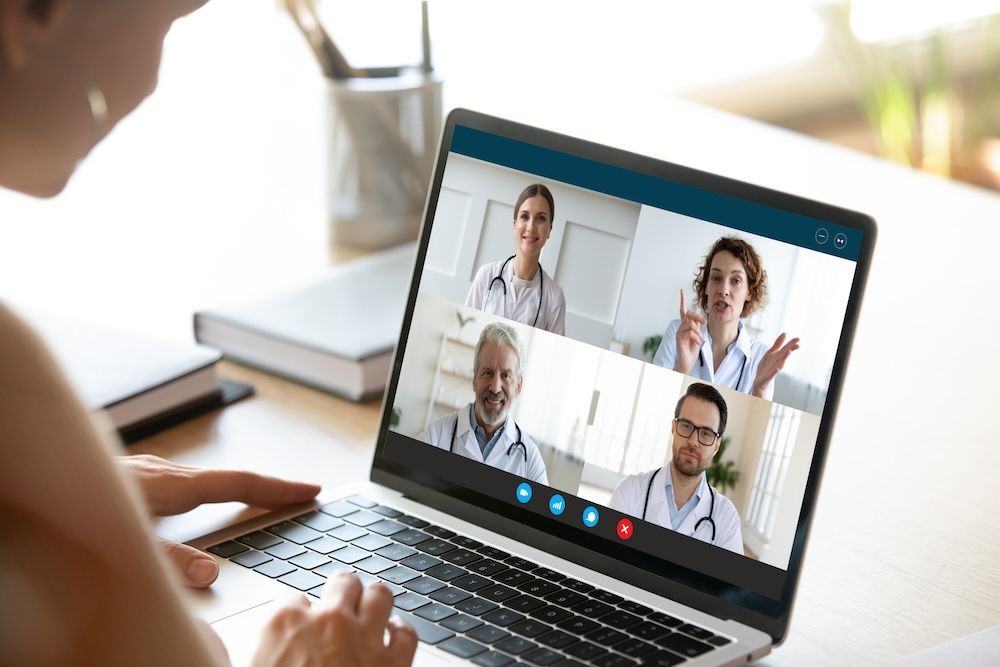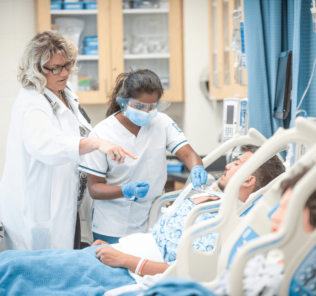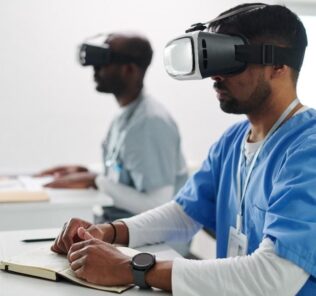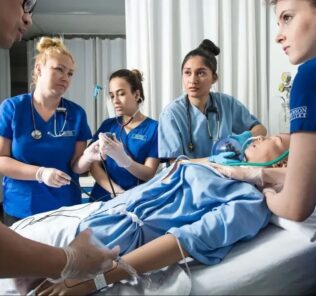Launch the New Year with Live CE/CME Healthcare Simulation Webinars This Month!
HealthySimulation.com is committed to providing the latest healthcare simulation webinars from leading experts around the world. In this article, we highlight all of the upcoming clinical simulation webinars on the HealthySimulation.com LEARN platform, all of which are open-access for the live recording and some of which provide CE/CMEs! Check out January’s webinars covering topics on IPE, wearable simulators, Virtual Reality, psychological contracting with learners, and more! All times listed are in the Pacific Savings Time zone, UTC-8.
January 10th, 9AM PST: Getting Started with Interprofessional Simulation and Wearable Simulators (Amy Cowperthwait, CEO, RN, CNS, MSN, CHSE-A): All health professions across the globe have been tasked to include interprofessional education (IPE) into their curriculum. In 2001 the Institute of Medicine issued the first call to action in the US. In 2010 the World Health Organization issued the alarm to a global audience. The creativity, adaptability, and repeatability of simulation-based education serves as a superior modality for IPE. Many institutions are discovering how the integration of Avkin wearables makes their IPE more impactful and transformative. Learning Objectives:
- Analyze current trends in interprofessional clinical simulation education.
- Discuss at least 3 solutions to common barriers when integrating IPE learning.
- Identify at least 2 strategies for successfully developing medical simulation-based IPE programs.
January 11th, 9AM PST: (CE) Taking the Leap into VR: How University of Manitoba is Innovating Healthcare Education (Kimberly Workum, RN, BScN, MEd, CCNE, CHSE): The College of Nursing at the University of Manitoba is excited to share an in-depth guide on incorporating virtual reality (VR) into healthcare education, highlighting the success of our expanded undergraduate nursing program that now includes over 1000 students. In this program, each student engages in 108 clinical hours of simulation, with a significant portion (one-third) dedicated to VR experiences in UbiSim. Over the past four semesters, students have spent more than 2400 hours in VR simulations, underscoring our dedication to cutting-edge and immersive learning. This presentation will cover various facets of VR integration, such as understanding the necessary equipment, choosing the right VR platform, fostering solid relationships with IT departments, and implementing effective strategies for onboarding faculty and students. It also emphasizes the importance of maintaining persistence and patience throughout the process. Ongoing evaluation of the VR program will also be discussed. Looking to the future, the presentation will outline the potential advancements of VR in healthcare education, with the goal of improving patient care and outcomes. The University of Manitoba is convinced of VR’s transformative role in both nursing education and practice. We extend an invitation to others to gain insights from our experiences and knowledge, equipping them with the necessary resources and understanding to maximize the use of VR in healthcare education. Learning Objectives:
Sponsored Content:
- Identify and describe the essential equipment, VR platform, and technological requirements for implementing VR in healthcare education.
- Understand the unique challenges and opportunities presented by VR technology in healthcare education and explore how to address common concerns and opportunities to improve clinical outcomes.
- Envision and plan for the future of VR, including how it can continuously be improved and expanded to enhance patient care and outcomes.
January 16th, 9AM PST (CE/CME): Mastering Learning Engagement: The Psychological Contract of Medical Simulation (Paul E. Phrampus, MD, MBA, FSSH, FACEP, CPE, CPPS): Considering the psychological or fiction contract between the learners participating in the healthcare simulation and the faculty / simulation program will enhance learner engagement and educational outcomes. Searching for opportunities to ensure a healthy relationship between learners and the healthcare simulation program is key to designing simulation encounters, whether they are a single engagement or part of a series of learner interactions. In particular, the challenging relationships between program design and practicing professionals engaging in medical simulation as learners will benefit from careful attention to successful outcomes and relationship building between a medical simulation program and its learners. Close knowledge gaps of physicians, nurses and advanced practice providers by attending to elements of the psychological contract that is often overlooked in simulation-based education program design. Join Dr. Phrampus in this CE/CME webinar to explore multiple aspects of improving the fiction contract associated with your clinical simulation educational program designs. Learning Objectives:
- Examine elements of the psychological contract of healthcare simulation
- .Identify three hidden components of opportunity targets for successful curriculum design.
- Compare and contrast the traits of practicing professionals participating in clinical simulations as learners.
- List three barriers to effective medical simulation learning for practicing physicians, nurses and advanced practice providers.
January 17th, 10AM PST (CE): Considerations for Developing, Improving, and Advancing Clinical Simulation Programs (Jennifer Furry, MSN, RN, CCRN-K, PCCN-K, PMP, CNML): This one-hour CE webinar is designed for current or aspiring medical simulation educators interested in learning about commonly overlooked or undervalued aspects of developing, improving, or advancing clinical simulation programs. During our time together, we will explore topics intended to expand thoughts, guide decisions, explore common equipment use/misuse/underuse cases, explore the importance of realism and immersion, provide some examples to support enhancing realism and knowledge transition to practice. The presenter will leave participants with a collaborative challenge which can change the way we train clinically, while significantly reducing the knowledge to practice gap. Learning Objectives:
- Recognize health, safety, and financial details which guide decision making when developing, improving, or enhancing a simulation program.
- Discuss the importance of realistic immersive scenario(s) to support learning and knowledge transition to clinical practice.
- Incorporate knowledge of potential patient safety concerns into simulation related decisions and suggest future simulation activities.
January 18th, 10AM PST: Customize Your Medical Training with the SimX Virtual Manikin Series (Tyler Andre, MD): Welcome to a new era of medical training with the SimX Virtual Manikin Series, where we blend cutting-edge virtual reality with the practicality of affordable and customizable simulation education. This exclusive webinar will demonstrate the revolutionary capabilities of the SimX Virtual Manikin Series, a groundbreaking tool that is reshaping the landscape of healthcare simulation. For years, traditional patient manikins have been the backbone of medical simulation, offering varying degrees of realism paired with complex technology. However, traditional manikin simulation comes with its own set of challenges, including high initial investment costs, intensive staff training, and ongoing maintenance. The SimX Virtual Manikin Series addresses these issues head-on, presenting a cost-effective, user-friendly next-generation immersive solution that drastically reduces the logistical and financial burdens traditionally associated with medical simulation.
This series stands out with its ability to offer thousands of unique patient encounters in one intuitive platform. It reduces the limitations of traditional simulation by introducing a virtual environment with patients that show neurological deficits, dynamic facial expressions, and other complex behaviors that can be vividly emulated. Unlike static manikins, the Virtual Manikin can interact with learners in real-time, providing an immersive, true-to-life clinical experience. Join us in this transformative journey as we demonstrate how the SimX Virtual Manikin Series makes medical training more accessible, realistic, and effective.
Sponsored Content:
Discover how it empowers educators and learners alike to push the boundaries of what is possible in medical simulation, all while maintaining a keen eye on affordability and practicality. This is more than just a technological advancement; it’s a step towards a more proficient, confident, and prepared generation of healthcare professionals. Learning Objectives:
- Discover key simulation insights for 2024: Explore how the SimX Virtual Manikin Series surpasses traditional methods in replicating dynamic patient encounters.
- Master Customization and Adaptation: Learn to tailor patient profiles, environments, and scenarios in real-time, enhancing the relevance and responsiveness.
- Experience Efficient, Affordable, Repetitive Learning: Understand the benefits of the Virtual Manikin’s ability to save and repeat scenarios, improving patient care.
More Webinars Coming Soon for January (Links Not Immediately Active):
January 30th, 10AM PST: The Creative Art Form of Healthcare Simulation: Increasing Realism & Outcomes (David Lee Mathews BA, MSHS): A healthcare simulation technician (HST) is a multifaceted role that relies on a broad range of knowledge. The addition of a healthcare simulation technician (HST) to a simulation-based healthcare education team can have a positive impact on the team’s ability to deliver quality simulations. A simulation technician typically has a core set of responsibilities such as event setup and breakdown, cleaning and evaluating any equipment used during the simulation, audiovisual support for courses, and any on-site simulator maintenance. Outside of these core responsibilities, HST’s engage in many other responsibilities based on the type of center and the programs supported by that center. However, identifying the training needs of HSTs is hampered by a lack of a clear understanding of the competency requirements of the role. A survey of simulation center directors found that only 2% of respondents found adequately qualified HSTs from an application pool. Creativity, out-of-the-box thinking, agility, and flexibility are just some of the characteristics ideal for a HST position and propose that hiring an artist or creative, and building an organizational culture that allows time and space conducive to creativity, innovation and on the job training has the potential to shape the Sim Tech position according to the needs of the simulation education team while also developing the individual professionally. The presenter will share several modifications, methods, best practices, innovations and work arounds developed during his journey as a simulation technician and creative specialist and how a background in the arts helped pave the way to a Master of science in healthcare simulation. Learning Objectives:
- Identity the knowledge, skills and attitude competencies conducive to success as a simulation technician candidate for your education team.
- Explore areas of simulation center operations where Simulation Techs can thrive outside of day to day equipment maintenance and core responsibilities.
- Discover methods, innovations and the importance of collaboration between educators, content experts in the early stages of scenario design.
January 31st, 9AM PST (CE): How to Conduct Research on Simulation-Based Educational Interventions Effectively (Amani Abdullah Azizalrahman, MD): This CE webinar will educate participants regarding how research can be used in simulation-based education. Topics covered include how to select and categorize the research and understand the obstacles researchers may face by designing research questions around simulation-based education to improve learner and patient outcomes. The presenter will highlight the benefits/pitfalls when using medical simulation in educational research such as variation, integration and productivity. Participants will create and share examples of simulation-based research by designing research questions around simulation-based education initiatives which support the improvement of clinical outcomes. Learning Objectives:
- 1Review how research can be used in healthcare simulation-based education, how to categorize the research and understand the differences between categories.
- Highlight the benefits/pitfalls when using clinical simulation in educational research.
- Understand the obstacles researchers may face by designing research questions around medical simulation-based education.
View all the Latest Healthcare Simulation Webinars
Lance Baily, BA, EMT-B, is the Founder & CEO of HealthySimulation.com, which he started while serving as the Director of the Nevada System of Higher Education’s Clinical Simulation Center of Las Vegas back in 2010. Lance is also the Founder and acting Advisor to the Board of SimGHOSTS.org, the world’s only non-profit organization dedicated to supporting professionals operating healthcare simulation technologies. His co-edited Book: “Comprehensive Healthcare Simulation: Operations, Technology, and Innovative Practice” is cited as a key source for professional certification in the industry. Lance’s background also includes serving as a Simulation Technology Specialist for the LA Community College District, EMS fire fighting, Hollywood movie production, rescue diving, and global travel. He and his wife Abigail Baily, PhD live in Las Vegas, Nevada with their two amazing daughters.
Sponsored Content:



















